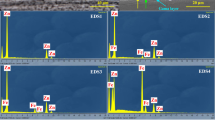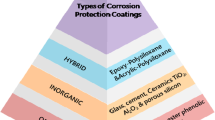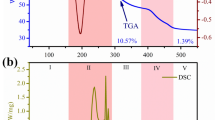Abstract
The current study indicates the application of three different range of hybrid sols on substrates. The aim was to achieve an optimum chemical composition on the silane- treated surface in terms of hydrophobicity and corrosion resistivity. Two different monomers including Tetraethoxysilane (TEOS) and Trimethoxypropylsilane (TMPSi) formed the hybrid sols. Sol-gel route was selected to enhance the corrosion resistance of the substrate (anodized aluminum). The role of the precursor’s molar ratios on the hydrophobicity was studied using static Water Contact Angle (WCA) and surface Roughness measurement (Ra). Owing to the evaluation by Field Emission Scanning Electron Microscopy (FESEM), a relatively smooth surface was revealed by silane-treated sample with TEOS: TMPSi, 1:0.5 M ratio. The sample prepared by TEOS: TMPSi, 0.5:1 M ratio sol illustrated a higher static water contact angle. To determine the corrosion resistance of the samples, Potentiodynamic Polarization, Open Circuit Potential (OCP) and Electrochemical Impedance Spectroscopy (EIS) measurements were performed using a 3.5% NaCl solution. Samples also were evaluated by Scanning Electron Microscopy (SEM) after seven days immersion in the same condition. According to EIS results, the sample treated in TEOS: TMPSi, 0.5:1 M ratio sol revealed the best corrosion resistance properties and minor deterioration of surface through the SEM micrographs.

.
Similar content being viewed by others
References
Zheng S, Li C, Fu Q, Li M, Hu W, Wang Q, Du M, Liu X, Chen Z (2015) Fabrication of self-cleaning superhydrophobic surface on aluminum alloys with excellent corrosion resistance. Surf Coat Technol 276:341–348
Calabrese L, Bonaccorsi L, Caprì A, Proverbio E (2014) Adhesion aspects of hydrophobic silane zeolite coatings for corrosion protection of aluminium substrate. Progress in Organic Coatings 77(9):1341–1350
Saberi F, Boroujeny BS, Doostmohamdi A, Baboukani AR, Asadikiya M (2018) Electrophoretic deposition kinetics and properties of ZrO2 Nano-coatings. Mater Chem Phys 213:444–454
Owens GJ, Singh RK, Foroutan F, Alqaysi M, Han C-M, Mahapatra C, Kim H-W, Knowles JC (2016) Sol–gel-based materials for biomedical applications. Prog Mater Sci 77:1–79
Balgude D, Sabnis A (2012) Sol–gel derived hybrid coatings as an environment friendly surface treatment for corrosion protection of metals and their alloys. J Sol-Gel Sci Technol 64(1):124–134
Gurav AB, Latthe SS, Kappenstein C, Mukherjee S, Rao AV, Vhatkar RS (2011) Porous water repellent silica coatings on glass by sol–gel method. J Porous Mater 18(3):361–367
Wang D, Bierwagen GP (2009) Sol–gel coatings on metals for corrosion protection. Progress in Organic Coatings 64(4):327–338. https://doi.org/10.1016/j.porgcoat.2008.08.010
Foroughi P, Rabiei Baboukani A, Franco Hernandez A, Wang C, Cheng Z (2018) Phase control during synthesis of Nanocrystalline ultrahigh temperature tantalum-hafnium Diboride powders. J Am Ceram Soc 101:5745–5755
Voevodin N, Jeffcoate C, Simon L, Khobaib M, Donley M (2001) Characterization of pitting corrosion in bare and sol–gel coated aluminum 2024-T3 alloy. Surf Coat Technol 140(1):29–34
Durán A, Ya C, Aparicio M, Conde A, De Damborenea J (2007) Protection and surface modification of metals with sol–gel coatings. Int Mater Rev 52(3):175–192
Fadavi M, Baboukani AR, Edris H, Salehi M (2018) Study on high-temperature oxidation behaviors of plasma-sprayed TiB2-co composite coatings. Journal of the Korean Ceramic Society 55(2):178–184
Ganbavle VV, Bangi UK, Latthe SS, Mahadik SA, Rao AV (2011) Self-cleaning silica coatings on glass by single step sol–gel route. Surf Coat Technol 205(23–24):5338–5344
Ren H, Qiao Z, Liu X, Cui X (2015) Hydrophobicity control by a supercritical drying technique in a sol–gel process with hybrid materials. Mater Res Bull 70:87–92
Wang H, Akid R (2007) A room temperature cured sol–gel anticorrosion pre-treatment for Al 2024-T3 alloys. Corros Sci 49(12):4491–4503
De Graeve I, Tourwe E, Biesemans M, Willem R, Terryn H (2008) Silane solution stability and film morphology of water-based bis-1, 2-(triethoxysilyl) ethane for thin-film deposition on aluminium. Progress in Organic Coatings 63(1):38–42
Gupta G, Pathak S, Khanna A (2012) Anticorrosion performance of eco-friendly silane primer for coil coating applications. Progress in Organic Coatings 74(1):106–114
Ramezanzadeh B, Rasi E, Mahdavian M (2015) Studying various mixtures of 3-Aminopropyltriethoxysilane (APS) and Tetraethylorthosilicate (TEOS) silanes on the corrosion resistance of mild steel and adhesion properties of epoxy coating. Int J Adhes Adhes. https://doi.org/10.1016/j.ijadhadh.2015.09.007
Sun J, Du D, Lv H, Zhou L, Wang Y, Qi C (2015) Microstructure and corrosion resistance of pulse electrodeposited Ni–Cr coatings. Surf Eng 31(6):406–411
Hinczewski DS, Hinczewski M, Tepehan F, Tepehan G (2005) Optical filters from SiO2 and TiO2 multi-layers using sol–gel spin coating method. Sol Energy Mater Sol Cells 87(1–4):181–196
Alibakhshi E, Akbarian M, Ramezanzadeh M, Ramezanzadeh B, Mahdavian M (2018) Evaluation of the corrosion protection performance of mild steel coated withhybrid sol-gel silane coating in 3.5wt.% NaCl solution. Progress in Organic Coatings 123:190–200. https://doi.org/10.1016/j.porgcoat.2018.07.008
Björkegren S, Nordstierna L, Törncrona A, Palmqvist A (2016) Hydrophilic and hydrophobic modifications of colloidal silica particles for Pickering emulsions. J Colloid Interface Sci 487:250–257. https://doi.org/10.1016/j.jcis.2016.10.031
Emarati SM, Mozammel M (2018) Fabrication of superhydrophobic titanium dioxide coating on AISI 316L stainless steel by electrophoretic deposition and using trimethoxy(propyl)silane modification. Surf Eng 35:456–465. https://doi.org/10.1080/02670844.2018.1523104
Liu S, Liu X, Latthe SS, Gao L, An S, Yoon SS, Liu B, Xing R (2015) Self-cleaning transparent superhydrophobic coatings through simple sol–gel processing of fluoroalkylsilane. Appl Surf Sci 351:897–903
Guglielmi M (1997) Sol-gel coatings on metals. J. Sol-Gel Sci. Technol 8(1):443–449. https://doi.org/10.1023/a:1018373404815
Whelan M, Cassidy J, Duffy B (2013) Sol–gel sealing characteristics for corrosion resistance of anodised aluminium. Surf Coat Technol 235:86–96
Baboukani AR, Sharifi E, Akhavan S, Saatchi A (2016) Co complexes as a corrosion inhibitor for 316 l stainless steel in H2SO4 solution. J Mater Sci Chem Eng 4(09):28
Rosero-Navarro NC, Pellice SA, Castro Y, Aparicio M, Durán A (2009) Improved corrosion resistance of AA2024 alloys through hybrid organic–inorganic sol–gel coatings produced from sols with controlled polymerisation. Surf Coat Technol 203(13):1897–1903
Adelowo E, Baboukani AR, Chen C, Wang C (2018) Electrostatically sprayed reduced graphene oxide-carbon nanotubes electrodes for Lithium-ion capacitors. C 4(2):31
Agrawal R, Adelowo E, Baboukani AR, Villegas MF, Henriques A, Wang C (2017) Electrostatic spray deposition-based manganese oxide films—from Pseudocapacitive charge storage materials to three-dimensional microelectrode integrands. Nanomaterials 7(8):198
Baboukani AR, Agrawal R, Khakpour I, Drozd V, Li W, Wang C (2018) Electrostatic spray deposited Sn-SnO2-CNF composite anodes for Lithium ion storage. Electrochemical Society Transactions (ECST) 85:331–336
Khoshkhou Z, Torkghashghaei M, Baboukani AR (2018) Corrosion inhibition of henna extract on carbon steel with hybrid coating TMSM-PMMA in HCL solution. Open Journal of Synthesis Theory and Applications (OJSTA) 7(01):1–16
Huang Y, Shih H, Huang H, Daugherty J, Wu S, Ramanathan S, Chang C, Mansfeld F (2008) Evaluation of the corrosion resistance of anodized aluminum 6061 using electrochemical impedance spectroscopy (EIS). Corros Sci 50(12):3569–3575
Sh C, Cai Y, Ch Z, Yu M, Song X, Zhang Y (2015) Electrochemical behavior and corrosion protection performance ofbis-[triethoxysilylpropyl] tetrasulfide silane films modified with TiO2sol on 304 stainless steel. Appl Surf Sci 331:315–326
Suay J, Gimenez E, Rodrıguez T, Habbib K, Saura J (2003) Characterization of anodized and sealed aluminium by EIS. Corros Sci 45:611–624
Montemor MF, Ferreira MGS (2007) Electrochemical study of modified bis-[triethoxysilylpropyl] tetrasulfide silane films applied on the AZ31 mg alloy. Electrochim Acta 52(27):7486–7495. https://doi.org/10.1016/j.electacta.2006.12.086
Hassannejad H, Moghaddasi M, Saebnoori E, Baboukani AR (2017) Microstructure, deposition mechanism and corrosion behavior of nanostructured cerium oxide conversion coating modified with chitosan on AA2024 aluminum alloy. J Alloys Compd 725:968–975
Yin Y, Liu T, Chen S, Liu T, Cheng S (2008) Structure stability and corrosion inhibition of super-hydrophobic film on aluminum in seawater. Appl Surf Sci 255(5, Part 2):2978–2984. https://doi.org/10.1016/j.apsusc.2008.08.088
Baboukani AR, Saatchi A, Wang C (2018) Electrochemical corrosion behavior of Ti-6Al-4V alloy using Akermanite as a bioceramic coating. In: Meeting abstracts. The electrochemical society, (14): 1043–1043
Ebenezer Adelowo ARB, Agrawal R, Wang C (2018) Electrochemical performance of Lithium-ion capacitor using reduced graphene oxide–carbon nanotube pre-Lithiated by direct contact method. Electrochemical Society Transactions 85:469–474
Zolfaghari S, Baboukani AR, Ashrafi A, Saatchi A (2018) Investigation the effects of Na2MoO4 as an inhibitor on electrochemical corrosion behavior of 316L stainless steel in LiBr solution. Zaštita materijala 59(1):108–116
Marcus P; Marcus M (2002) Corrosion mechanisms in theory and practice. Taylor & Francis ISBN 0824706668, 520–555
Gonzalez J, Lopez V, Otero E, Bautista A (2000) Postsealing changes in porous aluminum oxide films obtained in sulfuric acid solutions. J Electrochem Soc 147(3):984–990
Author information
Authors and Affiliations
Corresponding author
Additional information
Publisher’s Note
Springer Nature remains neutral with regard to jurisdictional claims in published maps and institutional affiliations.
Rights and permissions
About this article
Cite this article
Javanpour, B., Azadbeh, M. & Mozammel, M. Effect of Chemical Composition of Tetraethoxysilane and Trimethoxy(Propyl)Silane Hybrid Sol on Hydrophobicity and Corrosion Resistance of Anodized Aluminum. Silicon 12, 867–882 (2020). https://doi.org/10.1007/s12633-019-00180-y
Received:
Accepted:
Published:
Issue Date:
DOI: https://doi.org/10.1007/s12633-019-00180-y




